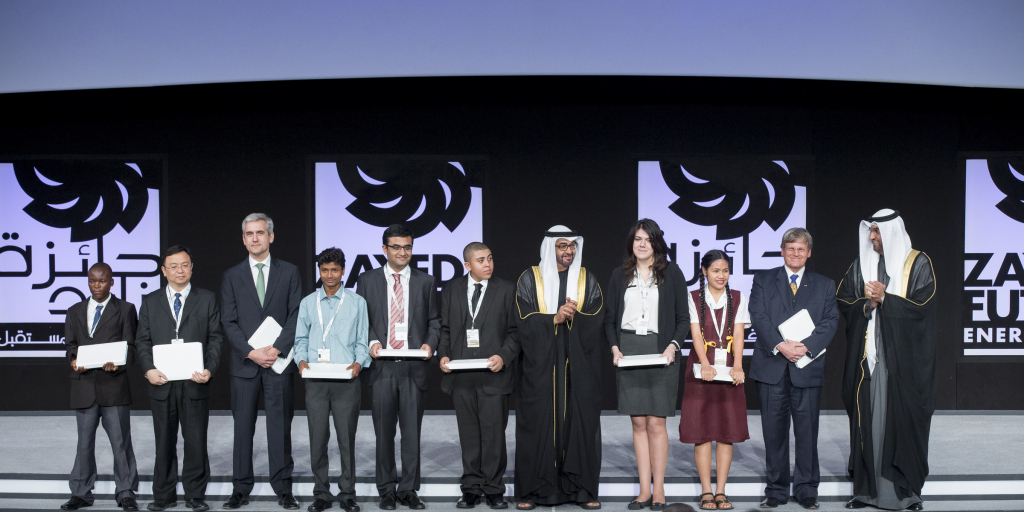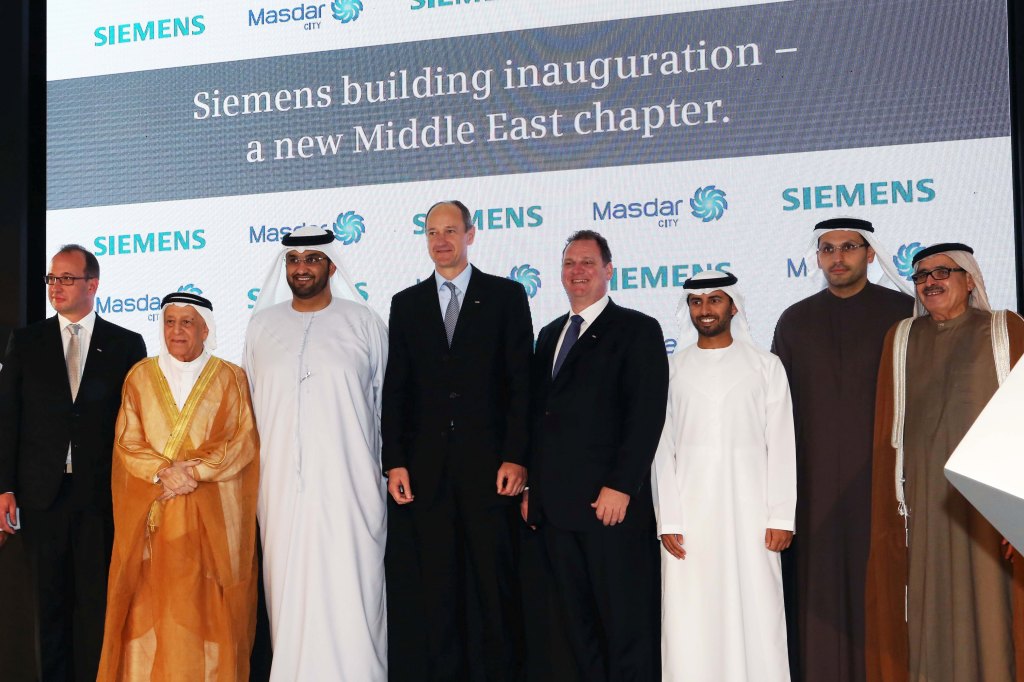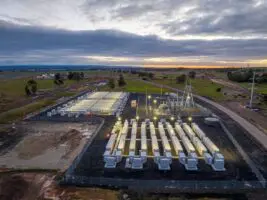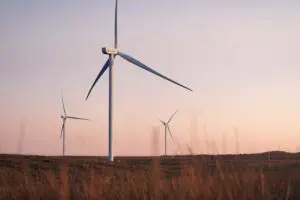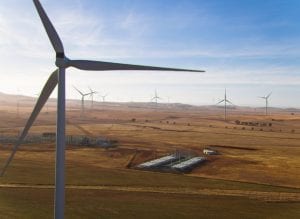Abu Dhabi likes to see itself as a global capital of renewable energy – but its ventures into sustainability are built on oil riches, which the country is not prepared to give up. Hypocritical? Perhaps, but it’s a hypocrisy shared by the rest of the world. Most countries and companies are pursuing an energy transformation which at the same time they are kicking down the road. And yet, writes Energy Post editor Karel Beckman in a relective essay after a visit to Abu Dhabi’s annual Sustainability Week, one day the oil companies may come to regret they have no plan B.
The drive through the desert to the concentrated solar power plant Shams-1 takes two hours. By bus, that is. By Lamborghini the 130 kilometres distance from the Capital to the South West of Abu Dhabi no doubt fly by a lot faster. But here in the desert – unlike in the glittering capital city – you don’t see many Italian racing cars. Mostly four-wheel drives. And trucks. Long lines of trucks. The Abu Dhabi economy is humming along nicely.
The reason Shams-1 – one of the largest CSP plants in the world – was built so far away, had to do with existing infrastructure, so our hosts tell us – a party of Western journalists who are taken by majority owner Masdar for a tour of Shams, as part of Abu Dhabi’s annual Sustainability Week (18-25 January). Gas and electricity distribution systems were there for Shams to be connected to. But the wild location does add to the plant’s mystique.
At first glance, Shams seems to be quite a success story. It makes for a good story anyway: 258,048 parabolic trough mirrors with a capacity of 100 MW produce 210 GWh of carbon-free solar electricity every year. The gleaming facility has the size of 285 football fields or 100 Sheikh Zayed mosques. Five trucks with robotic arms remove the dust from each single mirror twice a week.
A closer look reveals some cracks in the mirrors, however. As it turns out, Shams does not run fully on solar energy. It needs natural gas to run a booster heater that increases the temperature of the steam – which drives the turbine of the plant – from 380 degrees Celsius to the required 540 degrees. Fully 20% of the facility’s electricity production comes from gas.
“The role of renewables in the market place is growing dramatically”
Ernest Moniz, US Secretary of Energy
Then our hosts tell us they do not disclose the generation costs. According to an old Bloomberg story, construction costs were $600 million. Costs are perhaps not that relevant for a pioneering facility like this one. What is more disturbing is that we hear that no decision has been made yet on whether there will be a Shams-2, let alone a Shams-3, as the original plan had foreseen. In the meantime, Abu Dhabi has started on the construction of 4 new nuclear power reactors with a total capacity of 5600 MW. Shams-1, by the way, supplies 0.5% of electricity in Abu Dhabi.
The valiant but somewhat futile Shams project seems symbolic for the schizophrenic nature of Abu Dhabi’s energy situation. Abu Dhabi spares no expense to boost renewable energy. It boasts the famous sustainability showcase Masdar City. The government-funded Masdar company invests hundreds of millions of dollars in renewable energy projects around the world. Abu Dhabi is also host to IRENA, the International Renewable Energy Agency, a global UN-acknowledged promotor of renewable energy investment, which already has 124 member countries. It is also host to the annual World Future Energy Summit – one of the biggest renewable energy exhibitions in the world – and sponsor of the Sheikh Zayed Future Energy Prizethat has grown into a kind of Oscar award ceremony in the renewable energy sphere.
Zayed Future Energy Prize 2014 winners
The facts on the ground, however, tell a somewhat different story. Abu Dhabi has virtually no public transport. It has subsidized ultra-low gasoline prices. It has one of the highest CO2 emission rates per capita. And it has oil. Each and every day, the country pumps up 3.3 million barrels of fossil fuels.
So how serious are we to take Abu Dhabi’s efforts to create a sustainable energy future? There is no reason to doubt the sincerity of the leaders’ motives. The government also no doubt puts serious money into the promotion of renewable energy and energy efficiency – both at home and abroad. Yet at the same time it continues to invest in oil production and enhanced oil recovery. It surely has no intention of keeping its 98 billion barrels of oil in the ground where they are sitting now. Or, for example, to significantly raise energy prices for its citizens.
Here’s the dilemma for Abu Dhabi: without oil and cheap energy, it could not support its economic growth. And it could not afford to invest in alternative energy the way it’s doing now.
Of course it is easy to laugh at the little Oil Kingdom on the Gulf, promoting sustainability with its four-wheel drives and Lamborghini’s – but think again. Aren’t we all in the same boat? Aren’t virtually all countries in the world just as hypocritical: promoting renewables while at the same time continuing to invest in, rely on, or subsidize fossil fuels? Isn’t the US? China? Even a country like Germany, world leader in renewable energy, desperately hangs on to its coal and lignite. In truth, the world seems to be groping for an “energy transition” which is – if you look at it realistically – nowhere in sight.
*
“Bring this ad to hall 5 for a free Smart City puzzle and you can win an Ipad Mini! Download our free energy efficiency kit to learn about sustainable solutions for an energy-wise future! The only good watt is a negawatt!”
The slogans brandished about by the French energy management firm Schneider Electric at the World Future Energy Summit in the Abu Dhabi National Exhibition Centre tell the story. Sustainability has become trendy. Who can afford not to appear “sustainable” these days?
Tellingly, at the large show in Abu Dhabi dedicated to “future energy”, all the big oil companies are present, with large booths. Shell, ExxonMobil, BP. Even the Kuwait Oil Company is there, as is Kazakhstan (“Discover the Energy of Kazakhstan”). Is this progress? Or does it show that sustainability has become a catch-all concept that anybody can exploit for its own purposes?
Certainly no one could ignore the idea of sustainability today. Keryn James, CEO Asia Pacific of the large Australian consultancy firm Environmental Resources Management (ERM), who is a “sustainability advisor” to multinational companies around the globe and with whom I have a chance encounter in one of the big exhibition halls, says that the days are past when sustainability was the responsibility of a dedicated manager. Nowadays, she says, it is one of the top corporate issues to be dealt with at the highest decision-making level. “Chefsache”, as the Germans say.
Nor can there be any doubt that throughout the world a serious push is being made to put the world on a more sustainable energy course. Take the United States. Speaking at the World Future Energy Summit, US Secretary of Energy Ernest Moniz said the energy transition in the US was taking on real momentum. “Sometimes we lose perspective”, he said. “In the US in the last five years the deployment of wind energy has doubled. In 2012 wind was half of all new generation capacity, the other half was gas. In five years’ time, the cost of PV has dropped 75%, the price of LED lights 85%, the cost of batteries 60%. The role of renewables in the market place is growing dramatically.”
“Oil companies should not be exploring for new reserves”
Jeffrey Sachs, Director of the Earth Institute
The US government actively promotes R&D and demonstration projects to push technologies forward and lower costs, said Moniz. He gave several examples. “Through a loan guarantee program we supported five utility-scale PV projects. Now ten more are going forward. Also in the next three months we will commission two very large CSP plants both of which are equipped with six hours of storage. This will help tremendously to integrate solar.” Incidentally, Moniz noted that the US government is also still trying to promote the building of new nuclear power plants through a loan guarantee program. “The performance of nuclear plants in cost and scheduling will be a critical issue that will determine the future of nuclear energy in the US”, he said.
Japan, too, is investing heavily in renewables. The country has added over 5 GW in renewable energy capacity last year, said the Japanese Minister of Economy Toshimitsu Motegi. According to Motegi, Japan is also making major efforts in storage and demand side management. “We are building the world’s largest demonstration project to install a battery on the distribution grid”, said Motegi. “We also aim to create a new energy management system for the whole country. We want to be world leader in smart grids. And we want every household to have a smart meter by 2015.”
A real transformation
On a global scale, the International Renewable Energy Agency (IRENA) – the originally German initiative that found a home in Abu Dhabi and now has 124 member countries with 43 more waiting to accede – also seems to be gaining serious traction. In January it launched its Global Renewable Energy Roadmap(REMAP) which helps each member country to map out its own path towards a sustainable energy future. The overall goal is to double the share of renewable energy by 2030 to 36%.
At a lunch in Abu Dhabi during IRENA’s fourth Annual Assembly – which was attended by over 1,000 delegates from 167 countries and more than 120 organisations – Frank Wouters, the Deputy Director General of IRENA who until recently was head of Masdar Power, explained that the drawing up of REMAP had been a Herculean effort.
“We found that when we added up everything that countries were doing to stimulate renewable energy, we did not even come close to our target of doubling its share. We then had laborious discussions with each member country to see how we could improve matters – without being too prescriptive. We did all the numbers and calculated all the costs for them so they can see what they are up against. Actually, we found that additional costs were not all that large.” The biggest practical obstacle that Wouters said came out of the exercise is “to find a solution for sustainable biomass”.
Wouters optimistically noted that what REMAP adds up to is “a real transformation”. He acknowledged, though, that countries have not signed up to the REMAP program. It’s all voluntary in the end.
Still playing games
Here of course is where practical realities kick in. Most governments do undertake efforts to promote renewable energy and energy efficiency. At the same time they are not doing anything to discourage production and use of fossil fuels. On the contrary. Moniz, the US Energy Secretary, admitted as much in his speech: he said the US government, for all its support of renewable energy, will also continue to invest in fossil fuels.
“Personally I believe you need high fossil fuel prices to make the transition possible”
Wim Thomas, Chief Technology Officer of Shell
The same goes for the big energy companies. Indeed, companies like BP and Shell have largely withdrawn from renewable energy over the last few years. ExxonMobil never was much interested, except for its algae project. Total is an exception: the French oil major is investing heavily in solar power, both in PV and in CSP.
Jeffrey Sachs, the famous economist and Director of the Earth Institute at Columbia University in the US, put it succinctly in his keynote address at the World Future Energy Summit. “Countries and companies are only talking about the nice things they are doing, not about the bad things.”
Sachs baldly stated that “We are not solving the problem. We are still playing games.” He noted that some 1,000 coal-fired power plants are being built or planned across the world today. “We have to keep coal and oil under the ground”, he said. “Oil companies should not be exploring for new reserves. China has to move beyond coal. The US has never even made an energy plan.”
Sachs called for a massive energy overhaul: radically different building codes, huge investment in electric vehicles. But he realized he might as well have been calling out in the desert. “Our financial markets are even more short-term than our politicians. They have no idea how to finance a new energy industry. Pension funds use long-term savings to invest in short-term assets.”
Opening Siemens building Masdar City
Vested interests don’t like it
If you tell the big oil companies they should not be exploring for new reserves but instead put their money into alternative energies, they will tell you that such a course of action is simply not possible, given the huge demand for energy in the world. The line they have taken is that if we want to do something about greenhouse gas emissions, the way to go is substitute coal for gas.
Christof Rühl, Chief Economist and Group Vice President of BP, who is responsible for BP’s annual Energy Outlook and the annual BP Statistical Review of Energy, said in Abu Dhabi that renewables have a long, long way to go. “If you are serious about reducing emissions, you need to switch from coal to gas”, he said.
Rühl said his team had done some hard calculations. “Coal and gas each account for roughly a third of the global energy mix. Renewable energy is good for 2.4%. If you replace 1% of coal by gas that’s equivalent to an 11% increase in renewables.” This option, however, was not very often discussed, said Rühl, because certain vested interests don’t like it.
Wim Thomas, Chief Technology Officer of Shell, came up with a similar reality check in Abu Dhabi. “People are beginning to realize their jobs are on the line”, he warned, referring to the high energy prices in Europe. He noted that many people believe that “when you get large-scale renewables, it will bring down fossil fuel prices. Personally I believe you need high fossil fuel prices to make the transition possible.” He also noted that governments are often very dependent on revenues from fossil fuel activities.
Certainly companies like BP, ExxonMobil and Shell don’t seem too hot on renewable energy. ExxonMobil loses no opportunity to insist on the importance of “energy efficiency”. It does not invest in solar or wind power. Shell over the past decade made forays into solar power, second-generation biofuels and offshore wind energy, but in each case decided it was not their thing. The company is only active now in first-generation biofuels in Brazil and in hydrogen.
Is this a sustainable strategy? Now that Shell is increasingly being pushed out of the “easy oil” plays by national oil companies, has had to write off over $2 billion in the US shale sector, has decided to halt its activities in the Arctic after having wasted $5 billion there, and the new CEO Ben van Beurden has said he will divest any activity that’s not sufficiently profitable, it makes you wonder what Shell thinks its own “energy future” will look like. The company may yet regret that it does not have a plan B.
But that’s their problem, you might say. Our problem is what the world’s energy future will look like. Can the “energy transition” ever become a truly disruptive force in the world? If so, how?
Technological breakthroughs
Daniel Kammen, Distinguished Professor of Energy at the University of California, Berkely, who spoke in Abu Dhabi at the same session that Wim Thomas did, had a decidedly more bullish outlook on renewables than Thomas or Rühl. “We can see renewable-dominated systems emerge, not in 2050, but earlier, in the next few decades”, he said. He mentioned California and Germany as the prime examples.
“The company that will be able to provide affordable mass storage will change the world”
Ulrich Spiesshofer, CEO of ABB
According to Kammen the transition is in the final analysis what he called a “policy choice”. “Policy is key right now”, he said. As an example he mentioned that the State of California has mandated utility companies to develop storage capabilities. “Do we need this storage now? No. But if we build it now, we will have it when we need it.” He was also positive about the cap and trade system California has introduced which has established a carbon price with a floor price and a ceiling.
Bernard Clement, Director of the New Energy Division of Total, speaking during the same session, put a slightly different perspective on things. While he agreed with Kammen that (climate) policy remains an “important long-term driver” for investment in sustainability, he said competitive forces were also increasingly benefiting renewable energy. “Solar power relies much less on subsidies nowadays. In some place no subsidies are needed at all. Here in the Middle East for instance it makes sense to include solar in the energy mix.” He expected prices to continue to “go down significantly” over the next five years. “Industry growth in solar power will be huge.”
The transition may also yet come about by technological breakthroughs. One area that could be crucial for the advancement of renewables is electricity storage. Ulrich Spiesshofer, CEO of engineering company ABB – this year’s winner of the Sheikh Zayed Future Energy Prize in the category large companies – said in an interview after the award ceremony: “The company that will be able to provide affordable mass storage will change the world.” ABB has 9 teams working on different storage technologies, said Spiesshofer. “We are absolutely committed to become a leader in this.” But he did add that the whole energy transition is a long-term development. “The world will not have enough momentum to cover all of its power needs with renewable energy in the short term.”
Another breakthrough may come in the form of second-generation biofuels that the Masdar Institute is working on, in cooperation with Boeing, Honeywell and Etihad Airways. According to Boeing, research has shown that it is possible to grow plants (halophytes) in the desert that can live on salt water and that have an enormous potential for biofuels production. We reported on this development here.
What we did not report in our story, but which is interesting to note in this context, is that the Abu Dhabi National Oil Company (ADNOC), is also heavily involved in this project. According to Darrin L. Morgan, Director Sustainable Aviation Fuels and Environmental Strategy at Boeing, “there isn’t another example of that – a sovereign owner of a significant part of the world’s oil, leveraging its economic and technical abilities to drive a disruptive technology that in the US is seen as a polarizing political issue and is stalled.” Morgan notes that “oil companies are not generally helping aviation” to make a transition away from oil, with the exception of ADNOC and Total.
*
And then there is Masdar City. We have not talked about this yet: the famous “city of the future” which is being built not far from the Abu Dhabi airport and which is supposed to become a model for the “smart cities” our fast-urbanizing world desperately needs if it is to be a sustainable world.
You no doubt have read reports of Masdar City before (here is a good recent one). When it first got started in 2006, the sky seemed the limit – but the current reality is rather disappointing. The goal is to have 40,000 people live in Masdar City and 1500 businesses to have their offices there, but so far it is not much more than a small cluster of buildings in a corner of the desert. I was warned that “if you want to take a taxi out there, the driver may not know where it is”.
The buildings as such are quite nice, but they do not seem to be all that revolutionary. The architects have devoted a lot of attention to climate design – avoiding exposure to direct sunlight for example and maximizing exposure to the wind – with positive results: they use more than 60% less energy than comparable office buildings in Abu Dhabi. There is a 10 MW solar PV installation that produces as much electricity as Masdar City uses.
Masdar City
But that’s about as far as Masdar City has progressed. Nobody is living there yet except some students. Despite the zero taxes that the city offers, few companies have moved in so far. General Electric has opened an “EcoMagination” centre in Masdar, “the first in the world”. This sounds impressive, but on closer inspection it turns out to be nothing more than a bunch of fancy displays that you are likely to see in any modern science museum (or in Disney World). As to the PV installation, we were told that as the city grows further, it has no intention to build a microgrid or become fully energy neutral.
Yet, having said all that, it is certainly too early to write off Masdar City as a failure. With the worst of the economic crisis over, there are signs that development is picking up. Siemens chose Abu Dhabi Sustainability Week to officially open its new Middle East headquarters in Masdar City. The German engineering company will move in 800 people there. Other companies may follow. The Masdar Institute is conducting serious research there with the support of MIT in the US.
What is more, anyone who has been to Abu Dhabi knows that the resolve of the country’s leaders is not to be underestimated. Masdar City is only at a tenth of where it will be in the end, we were told. What you see now is only a start.
“The energy transition is about you and me who can change the world”
Ad van Wijk, Professor of Future Energy Systems at the Technical University of Delft
But there is an even more important point to be made about Masdar City. It has also served another purpose. As Adnan Amin, Directory-General of IRENA, put it at a press conference in Abu Dhabi: Masdar has “raised awareness” in a region that is generally not known for being too aware of energy efficiency or renewable energy – or climate change for that matter.
“Awareness” is undoubtedly one of the least quantifiable and most unpredictable factors in the energy transition. It may not make a difference at all – or it may make all the difference.
Ad van Wijk, Professor of Future Energy Systems at the Technical University of Delft in the Netherlands, and the author most recently of a book entitled “Our car as power plant”, perhaps said it all when he said at one of the sessions: “The energy transition is about you and me who can change the world”.
*
On the plane back from Abu Dhabi, reflecting on all I had heard and seen, I got into a conversation with a fellow passenger – a Canadian Muslim who worked in the construction industry in Saudi Arabia. We talked about our beliefs and he told me Muslims watch for small and large signs indicated in the Koran which foretell The End of the World. He said one of the large signs Muslims are watching out for was when Arabia will once more be covered with forest and rivers, as it was in prehistory. If that happens, he said, Judgment Day is close at hand.
He may be right, I thought. One day when the deserts are gone and forest and rivers will take their place, it may be the end of the world. And the beginning of a new one.


